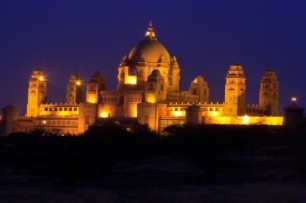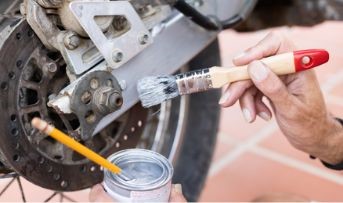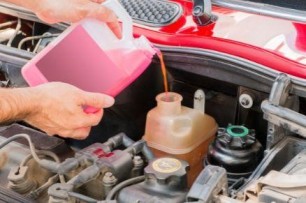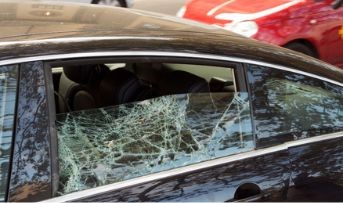General Insurance Blogs, Articles & Updates by - Magma HDI
Have us call you
- RENEW YOUR POLICY
- BUY NEW POLICY

Visit these exclusive palace hotels to enjoy the rich culture and heritage of India
India has long been recognised for its illustrious past and imperial way of life. Its royal palaces were formerly the official residences of royal families but have since been turned into luxury historical hotels with old-world elegance and modern comforts.
Plenty of great palace hotels, particularly in the state of Rajasthan, are now open to visitors. You can visit these exquisite heritage hotels for your extended weekend plans and summer vacations. All of the listed hotels provide splendid service and a more personal experience.
Here are the four Indian palaces turned into hotels where you may indulge the maharaja inside you.
1. Taj Lake Palace, Udaipur:
The Taj Lake Palace in Udaipur is a historic hotel with magnificent rooms and many grand suites. Its location on an island in the middle of the lake Pichola provides exceptional sights of the nearby Aravalli hills, City Palace and Jag Mandir from each room.
The breathtaking setting is ideal for the delicious cuisine served at Taj Lake Palace's fine restaurants, solely available to resident guests. Udaipur, dubbed as the Venice of the East, has a great deal to offer with its spectacular palaces, serene lakes, fascinating temples, and beautiful gardens.
2. The Lalit Grand Palace, Srinagar:
The hotel was designed and constructed by Maharaja Pratap Singh during the 1900s. It has witnessed significant events in India's history and proudly continues the royal lineage with elegance.
It maintains well-equipped luxury suites, including cottages with spectacular design, an ample dining space, and a retail arcade. This beautiful palace is surrounded by the Himalayan peaks and overlooks the gorgeous Dal Lake.
3. Umaid Bhawan Palace, Jodhpur:
This piece of art built between the 1920s and 1940s is part of Rajasthan's legacy and a symbol of contemporary Jodhpur. The palace, formerly home to the royal family of Jodhpur, is now the world's 6th biggest private property.
One common feature that this property shares with Agra's Taj Mahal is the palm court marble used in its design. The palace is situated on Jodhpur's highest point, the Chittar Hills. Get impressed with unique views of the old Blue City, vast dunes, and the magnificent Mehrangarh Fort as you stay here.
4. Rambagh Palace, Jaipur:
Rambagh Palace, established in 1835, was home to Sawai Man Singh II. This jewel of a hotel has magnificently refurbished big luxury rooms and suites that were the erstwhile Maharaja's bedrooms once upon a time.
The palace has been lavishly embellished with hand-carved marble and beautiful Mughal Gardens. Immerse yourself into the finest of Rajasthan's royal history within this splendid palace.
Heritage hotels in India provide a royal treatment to the inner maharaja inside you. They are as stunning, if not more so, than any of Europe's colossal castles or impressive palaces. These remarkable palaces ensure a great and unique holiday to be remembered for years to come. As you plan your visit to these genuinely magical places, make sure you add general insurance to your checklist. Get the best plans for yourself from the most trusted general insurance company and make your travel plans safe and stress-free this summer.
Click HERE to buy insurance from the best general insurance company.
Disclaimer: The information provided above is for illustrative purposes only. To get more details, please refer to policy wordings and prospectus before purchasing a policy.

Here are the top things to consider before you buy a used motorcycle
The volatility of employment and predicting an incoming global economic recession are challenging. These make the consumers to save for tomorrow rather than spend on luxuries and comforts today. While motorcycles are cheaper than cars, they are by no means easy to afford with rising inflation, fuel costs, and other allied servicing costs.
This often leaves a majority of potential buyers to consider a second-hand motorcycle. While many have concerns about buying used motorcycles, by doing due diligence, inspecting the vehicle's mechanical condition, and purchasing two-wheeler insurance India, you can get your hands on a beneficial asset that can provide you with value for years to come!
Here is a checklist of bike parts and inspections to run through before purchasing a used motorcycle.
1. Engine:
The engine is the heart of any vehicle. To check the engine's condition, request the seller not to run the bike. A cold start is the best way to gauge the engine's usage and wear and tear. Look out for smoke from the exhaust pipe or any sputtering noises. Oil leaks are another sign to keep a watch for.
2. Drive chain and sprocket:
While these components may seem highly technical, they are readily identifiable parts in all two-wheelers. Simply put, it refers to the bike chain and the chain wheel, which facilitate gear engagement, acceleration, and power transmission.
Ideally, the chain should only have a slack of three-fourths of an inch to function appropriately and should not shift off the wheel when prodded. If the wheel displays signs of corrosion or wear and tear, it indicates a poorly-maintained bike. Ensure you list your dissatisfactions and factor them in when negotiating a fair price with the seller.
3. Tyres:
Well-maintained tyres are essential for a safe riding experience. Put the motorcycle on its centre stand and check its tread depths. Ensure that they are not too deep, which results in poor gripping and an excess risk of accidents. Cracks along the inner side or rubber toughening are signs of weathered tyres.
Also, check the wheel alignment by spinning the rear wheel. Any wobbling or creaking are indicators of weathered wheel bearings which require replacement. Ensure you check the tyres thoroughly to estimate the cost of repairs and acquisition of the used motorcycle.
4. Visible frame:
The motorcycle's frame can be challenging to inspect depending on the effort spent to spot the issues. Scratches and dents may be the signs of accidents that inevitably affect the overall functionality of the bike's components.
In case you purchase such bikes, even after buying two wheeler insurance India, you may not be able to claim the insurance amount due to the vehicle's poor condition before the accident.
5. Under-seat storage:
An often overlooked part, the under-seat storage locking mechanism, must be checked when purchasing the vehicle. Feel around the space underneath the seat to ensure that it is steady to fit your belongings.
6. Odometer:
Contrary to popular belief, it is easy to replace an odometer. Sellers of old vehicles can tamper with the odometer and try to sell off an old bike as a relatively new one. After inspecting the motorcycle as per the above checklist, check the odometer reading. Ensure that it is aligned with the condition of the vehicle.
While this is not a comprehensive list, it covers the essential things to check before purchasing a used motorcycle to protect yourself from misrepresentation and unfavourable deals. Additionally, since used bikes have a relatively unsafe perception, we recommend buying 2 wheeler insurance online to protect yourself from the risk of financial losses due to accidents.
Click HERE to buy a robust 2 wheeler insurance online for your motorcycle.
Disclaimer: The information provided above is for illustrative purposes only. To get more details, please refer to policy wordings and prospectus before purchasing a policy.

What happens to your car's engine if you drive it without coolant for long
Much like oil, the coolant in your car is a special fluid that can't be overlooked. Although, in comparison to oil, the coolant needs less attention. Car owners often tend to neglect it, which can severely damage the vehicle and potentially be life-threatening.
This post will give you a clear idea about what will happen if you drive with low or no coolant.
What is coolant?
Coolant is a combination of water and antifreeze. It has a greater boiling point than water, and works at higher temperatures and pressures to regulate the heat generated in the engine. It takes heat from the engine and radiates it back into the atmosphere via your radiator.
Here are the effects of driving with insufficient coolant.
1. Overheating:
The main function of a coolant is to extract heat from the engine. A shortage of coolant may cause your car engine to overheat. If you continue to run an overheated engine, there could be irreversible damage, such as pistons welding to the cylinders.
2. Engine cutoff:
Modern vehicles feature a safety mechanism that will turn off the engine if it suffers considerable damage due to a lack of coolant. Although this function can help you save on engine repairs, it can leave you stranded on the road.
3. Damage to the water pump:
The water pump’s function is to circulate coolant throughout the engine. The pump will continue to run dry if there is insufficient coolant. If the pump goes dry, racks and pockets of air will form in the coolant channel. This increases the pump’s burden and can destroy it permanently.
4. Damage to engine:
The engine blocks are not the only sections that can be damaged by overheating. Many other components can become exposed to heat.
Below is the overview of parts that may suffer the wrath of an overheated engine:
• Head gaskets
• Cams and pulleys
• Warped or bent connector rods
• Crankshaft
• Piston timing
• Connecting rod
5. Decreased mileage:
Your car's engine will be less efficient if you don't have enough coolant. Friction generates more heat, which means more energy is spent. As a result, the fuel efficiency is dismal.
How to identify low coolant levels?
1. Dashboard Warning:
The coolant warning light will light up on your dashboard when car sensors detect a low level of coolant. Keep an eye on your dashboard; it is essential to note that not all cars, especially the older ones, have this feature. Therefore, consider manual checking of the level periodically.
2. A.C. blows hot air:
If your AC unit starts blowing hot air, it is a sign of a lack of coolant.
3. Lower mileage:
Your car starts to consume more fuel per km and shows reduced engine performance.
4. Temperature gauge rise:
The temperature levels of internal components start showing an unexpected spike due to the low level of coolant.
It is vital to make regular coolant checks a habit. If your car's coolant runs out, pull over immediately. Let the engine cool to a safe operating temperature before going to the nearest garage.
If you're unable to drive to a garage, have your car towed to avoid the risk of further damages. Car insurance proves to be a valuable investment in such situations. So, purchase a car insurance policy that provides you with your desired benefits and adds value to your four-wheeler.
Click HERE to invest in ideal car insurance that meets all your requirements.
Disclaimer: The information provided above is for illustrative purposes only. To get more details, please refer to policy wordings and prospectus before purchasing a policy.

Here are a few security regulations that the next-generation cars need to adapt
Technological advancements are visible in a country like India, where economic developments are happening rapidly. These changes are accelerating the growth in all sectors, including the automobile sector. The car industry is an essential growth driver of the Indian economy, and a lot is yet to be done in this field.
Additionally, the Indian economy is set to grow by 7.4% in the coming years. This will significantly impact the automotive industry as well. Car sales in the country have grown by 50% in the last few years, and it is set to record more in the coming years. Automobile ownership will take a giant leap and be a convenient option for most commuters.
However, with such growth, the risks also increase. This also leads many fraudsters to take different ways and means to hack and steal. As the existing state of motor security in India is inadequate, every motor insurance company in India is trying to protect people against such crimes.
All next-generation cars must follow more security regulations to address these challenges. Let's have a detailed look at them.
What is the current scenario of vehicle security in India?
Like everything else, the car security statistics of India are not satisfactory. Every year, more advanced means of theft are discovered. Car theft, hijacking, and robbery are common matters these days. The cars are also more prone to theft because there aren't enough safe parking spaces, which makes them easy targets for carjackers.
What is car hacking?
The automotive industry is under the radar of cyber criminals every day. As the technology is being developed, the risk increases. Vehicles are more connected and automated than ever. This allows cybercriminals to hack into the system and steal valuable data.
They make use of malware to get into the vehicle's system and gain access to all the connected devices as well. These mischievous minds can use this to steal financial data, personal information, and the car.
They make use of malware to get into the vehicle's system and gain access to all the connected devices as well. These mischievous minds can use this to steal financial data, personal information, and the car.
What can be done to prevent it?
After the car theft crime rate is increasing rapidly, the Indian government initiated various guidelines for the automobile industry. These security regulations need to be thoroughly followed by all future vehicles. These rules will keep drivers safe and expect to reduce the crime rate. These are
1. Security standards:
The government is trying hard to elevate the safety standards of vehicles. This means that all vehicles need to be equipped with GPS trackers in the future. Additionally, an anti-theft device should be placed too.
2. Using a High-Security Regulation plate:
HSRPs come with a non-removable snap-on lock which is irreplaceable. All the vehicle details, like chassis and engine numbers, can be collected and stored in a secure database using HSRP. These unique number plates will bring uniformity by eliminating the use of fancy plates. This can also aid authorities in easily tracking your vehicle's registration number.
3. Update all software:
It is crucial to regularly update all security patches of your vehicle's firmware and other IoT software to eliminate any possibility of hacking or breaches. Another advanced solution for connected vehicles includes public-key infrastructure (PKI) that ensures a superior level of security.
4. Awareness:
Regular awareness drives and car security campaigns are mapped out for all car owners so that they can be prevented from theft. This also includes educating them about tracking devices, hacking, etc.
5. Accessible public transportation:
The government is creating a massive public transportation infrastructure for the general public's convenience. Buses and metros are being developed every day, and more cities are being included in the list of metros. This will reduce the dependence on private vehicles.
The future of next-generation cars relies on technology. GPS trackers, Bluetooth connectivity, and anti-theft devices are the future of the automotive industry. They will be mandatory in the future. Every motor insurance company is considering them while planning out their insurance policies.
Click HERE to buy a policy from the best motor insurance company.
Disclaimer: The information provided above is for illustrative purposes only. To get more details, please refer to policy wordings and prospectus before purchasing a policy.


